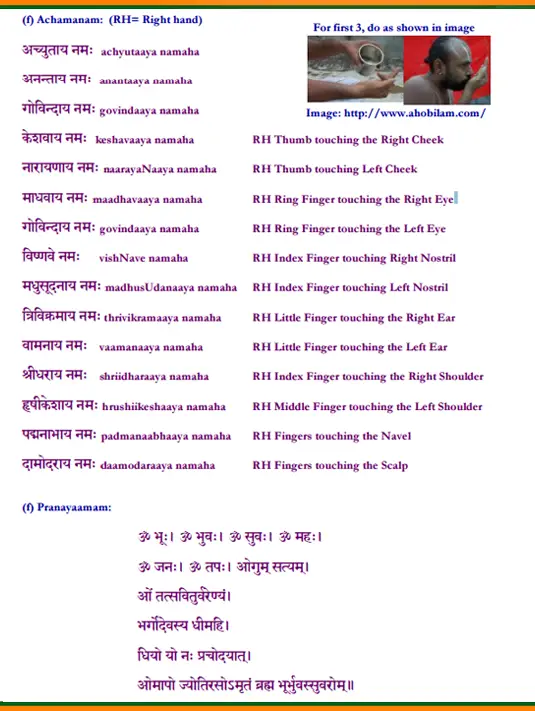The 2 Kinds of Knowledge: Para & Apara Vidhyas.
The great tradition of the transmission of knowledge through AchArya Mukham is recorded in Mundaka Upanishad as a conversation between BrahmA, the creator and his eldest son, AtharvA about the knowledge of BRAHMAN, the corner stone of ALL knowledge. AtharvA taught what he had learned from his father to AngirA, who in turn taught it to SatyavAhA
belonging to the clan of BharadvAjA; SatyavAhA passed that supreme knowledge in succession to Sage Angiras.
SaunakA, the celebrated grahasthA approached Sage Angiras and asked humbly: “O Illustrious sage! kasminnu BhagavO vig~nyAthE sarvamidham vig~nAtham bhavathee? (What is that by the knowing of which all this becomes known?)
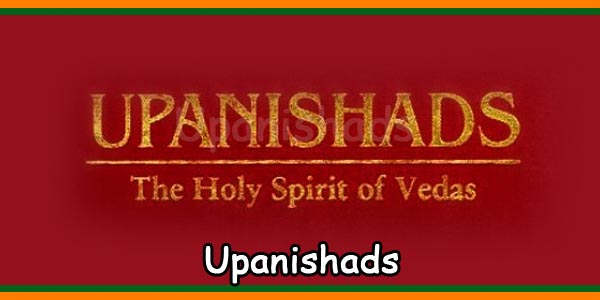 Angiras replied: “two kinds of knowledge needs to be known according to the knowers of Brahman. They are the higher knowledge (parA) and the lower knowledge (aparA)”.
Angiras replied: “two kinds of knowledge needs to be known according to the knowers of Brahman. They are the higher knowledge (parA) and the lower knowledge (aparA)”.
Sage Angiras explained further that the lower knowledge is the Rig Veda, the Yajur VedA, the Saama VedA and Atharva VedA, SikshA (phonetics), kalpA (rituals), vyAkarNam (grammer), NirukthA (etymology), chandas (metre) and JyOthisham (astronomy); and the higher knowledge is that by which the imperishable Brahman is attained.
Sage Angiras said: “dhvE vidhyE vEdhithavyE ithi ha sma yadh BrahmavidhO vadanthi ParA chaivAparA cha”. AparA are the four VedAs and their six angAs to understand the nature of DharmA and the ParA is the knowledge about the imperishable (akshaya) Brahman, which is the embodiment of DharmA. That omniscient, Omnipotent, all merciful Brahman has been defined as the source/origin, sustenance and dissolution of this multifaceted world according to the second Brahma sUthrA (JanmAdhyasya yatha:). That Brahman is cognized only through the scriptures, the sources of authoritative knowledge about Brahman (Saasthra yOnithvAth:
Brahma-sUthram 1.3).The next Brahma sUtram goes on to point out that Brahman is the main purport of all Vedic and upanishadic texts (tatthu samanvayAth). Thus one can not dismiss the VedAs quickly as apara vidhyA and jump on to Para vidhyA. Rigorous study of the VedAs reveal to us the approach to Brahman, the para VidhyA, the ultimate goal for us all.
The Four Categories of Knowledge in the Vedas:
The Four Vedas Contain Four Important Categories of Knowledge Related.
To Dharma:
(1) Injunctions and Prohibitions
(2) Valedictory (praise) and deprecatory passages
(3) MantrAs and
(4) Names
All these four are necessary to understand true DharmA or righteous duty from different angles. Thus an inquiry in to them through the study of the VedAs becomes an essential pre-requisite in one’s journey towards the comprehension of Brahman (para VidhyA). The authority of the VedAs for us is supreme and final and hence a proper understanding of them with the help of a qualified AchAryA sets us on a safe footing to comprehend Brahman and achieve the parama purushArtham of Moksham. Our tradition is therefore called Vaidhikam or the one based on the authoritativeness of the VedAs.
The Four Kinds of Veda Samhithas:
Atharva Samhitha.
Rig, Yajur, Saama and Atharva samhithAs constitute the four VedA samhithAs. Each of them
have more than one branch (SaakA). The oldest VedA is recognized as Rig Vedam and the
youngest is the Atharva Vedam. Latter has nine branches or rescensions (navadhAatharvaNO
veda:). These nine branches are: (1) PaippalAda (2) Tauda (3) MuNda (4) SaunakIya (5) Jaajala
(6) Jalada (7) BrAhmaveda (8) Devadarsa and (9) ChAraNavaidya. Today, only two of the nine
branches of Atharva Vedam (Saunakha and PaippalAda) are available to us. The Delhi Vedic
trust has recorded the Saunakha sAkA .
The Atharva Veda samhithA has 5977 verses spread over 20 KhAndams (books/chapters). The
khAndams are further subdivided into hymns and they in turn house a group of manthrAs.
Some prefer to catalogue the Atharva Veda Text (SamhithA)into prapaathakAs (Lessons or
lectures). Under this classification, there are 34 prapAthakAs that house the 5977 verses.
Among NammAzhwAr’s four Tamil Prabhandhams, Periya ThiruvanthAdhi is considered as
the essence of Atharva Vedam.
The Delhi Vedic trust has recorded the 20 KhAndhams of Atharva Vedam in 14 audio tapes. I
have now enjoyed listening to two of the twenty khAndams.
Rig Veda Samhitha.
This ancient Vedam has 1,028 sUkthams (hymns) and contains in all 10,589 verses. These are
grouped into either 8 KhAndAs or 10 MandalAs with 85 anuvAkAs (subsections). There used to
be 21 sakAs (redactions) of the Rig VedAs. There is only one available today. That is Saakala
SaakA. IythrEya Upanishad belongs to Rig Veda SamhithA. NammAzhwAr’s Thiruviruttham
is considered as the Veda SaarArtham of Rig Vedam.
The Delhi Vedic Trust has recorded Saakala sAkA in 27 ninety minute tapes. During my
father’s sathAbhishEkam celebration, there was one Rig Vedic expert from Mayavaram, who
recited that samhithA. He was lost in the ghOsham of Saama and KrishNa yajur Vedams. My
great desire to hear the authentic rendition of the Rig Vedam is now satisfied.
Yajur Veda Samhitha:
This Vedam has 1975 verses grouped under 40 chapters known as adhyAyAs. The longest chapter has 117 “verses” and the shortest chapter has 13 “verses”. There are two Yajur samhithAs: Sukla and KrishNa (White and Black) samhithAs. The White Yajur Veda samhithA is also known as VajasanEyi -MadhyAndina Sukla Yajur vedam to distinguish it from KrishNa Yajur Veda or Taittiriya SamhithA, which is generally considered to be more close to a BrahmaNA rather than to a Sruthi. Most of the people in AndhrA and Tamil Naadu are KrishNa Yajur Vedins.
The two samhithAs have number of recensions in view of their wide popularity. These
variations arose from a variety of textual differences and their applications in Vedic rituals. The two popular recensions of the Sukla Yajur Vedam are: MaadhyAndhina and KaaNva; the KrishNa Yajur Vedam has three recensions: kAtaka, Kapishtala-Kata and MaithrAyaNee.
Saama Samhitha.
In its importance in YaagAs and sacredness, Saama Veda SamhithAs rank next to Rig VedA.
The Lord of GeethA however has put this Saama samhithA on the top of all four SamhithAs
with His declaration that He is Saama VedA among the VedAs. This samhithA consists of
hyms chanted by udhgAtri priests at the Soma YaagAs. Many of the hymns originate from Rig
Vedam and have been rearranged without reference to the original order in the Rig Vedam and
set to music. Only 75 verses of the total of 1,875 verses of Saama Vedam are not to be found in Rig Vedam. The remaining 1,800 verses are essentially the repetitions of Rig Vedic verses. The important distinction however is that they are sung instead of being recited. The Rig Vedam deals with knowledge and Saama Vedam deals with UpAsanA, Worship and DhyAnam.
According to one classification, the Saama samhithA is catalogued under two sections:
PurvArchikA and UttarArchikA. Each archikA is subdivided into prapaathakAs and adhyAyAs.
In another classification, the 1875 verses are grouped under FOUR categories:
1) PurvArchikA: 585 verses (1-585)
2) AraNya KhAndam : 55 verses (586-640)
3) MahAnAmnyArchikA : 10 verses (641-650)
4) UttarArchikA: 1225 verses (651-1875)
In singing, the priests of the Yaj~nams follow specific styles through alteration of prolongation, repetition, modulation, rests et al. These become the various styles of Saama GhAnams: congregational (GrAma gEya GhAnam), AraNya ghAnam (Forest song style), Uha ghAnam and Uhya GhAnam.
Saama Vedam had originally 1001 branches. We have very few left now. NammAzhwAr’s celebrated Thiruvaimozhi is recognized as the Saama Veda SaarArtham.
Upanishads And Veda Saakaas:
Upanishads are found in the concluding sections of the Veda Saakaas and hence are known as
Vedanta or the end of the Vedas. There are four Veda Samhitas (Rg, Yajur, Sama and Atharva). The Yajur Vedam has two Samhitas known as the Krishna and Sukla Yajur Vedas. Hence, One can say that there are 5 Veda Samhitas, if we take into account the 2 Samhitas of Yajur Veda. Each of the 4 Samhitas referred to above has several branches or Saakaas. Each Saaka has a Karma Khanda dealing with the actions to be performed and is made up of Mantras and Btrahmanaas. Latter deals with Upasana or meditation and has Aranyakas inside them for the benefit of those who have resorted to the quiet habitat of the forest to pursue their spiritual Quest. The Upanishads are found mostly in the Aranyaka section of the Vedas.
The traditional view is that Vyasa Bhagavan has classified the four Vedas into 1180 Saakaas and each of these Saakaa is associated with an Upanishad. Hence, One anticipates 1180
Upanishads. According to this view, there must have been 21 Upanishads for the 21 Rg
Saakaas, 109 for Yajurveda, 1000 for Sama Veda and 50 for the Atharva Veda. Most of these
Saakaas have been lost with the passage of time and we are left with 108 Upanishads today. The breakdown among the 108 Upanishads according to the 5 Veda Samhitas are as follows:
1) Rig Veda: 10
2) Sama Veda:16
3) Atharva Veda: 31
4) Krishna Yajur Veda: 32
5) Sukla Yajur Veda: 19
The Significance of Upakarma:
An Explanation of the Vedic Ritual of Yajur Upakarma, known in Tamil as “Avani Avittam”
Contribution by Vijayaraghavan Srinivasan.
Upakarma (Avani Avittam): Nature & Purpose.
Upakarma (/upaakarma/) means beginning or “Arambham”, i.e. to begin the study of the Veda (Veda Adhyayanam). For example, Yajur Upakarma means to begin the study of the Yajur Veda. Those belonging to the Yajur Veda observe the Upakarma in the month of Sravana (August-September), on the day of the full moon (paurnami). Why begin study of the Vedas on this particular day? This auspicious day also happens to be the day when Lord Narayana took the avatara as Lord Hayagriva. Lord Hayagriva as we all know restored the Vedas to Brahma and also is the God of Knowledge.
The next question is: why do this every year? In the not too distant a past, Veda Adhyayanam
was performed only during the period Avani to Tai (from mid-August to mid-January). Therefore, one is supposed to perform an “utsarjanam” in the month of Tai, i.e., a giving up of the learning of Vedas from Tai to Avani. Just like a Upakarma function there was a Utsarjana function in Tai. The period between January to August was then devoted to learning other branches of our shastras. Thus the cycle of Upakarma and Utsarjana with regard to Vedic
studies was established. However, this method took 12 or more years to learn just one veda.
Slowly this became impractical and Vedic studies continued throughout the year.
Therefore, the first thing to do before the Upakarma function is to do a praayaschitta (atonement) for having learned Vedas during the prohibited period. Specifically, one atones for not having performed the Utsarjanam in the month of Tai. That’s why we begin the function by doing the “kAmo’ karshIt…” japam. The purpose is declared as “adhyAya-utsarjana-akaranaprAyaScittArtham..” (to atone for not doing the utsarjana of Vedic study) and the sankalpam continues as “…ashTottara-sahasra-sankhyayA kAmo’karshIt manyur akArshIt mahA-mantrajapam karishye” (I will now do recite the great “kAmo’kArshIt” mantra 1008 times). The
meaning in Tamil is “kAmaththAl seyya pattadhu, kOpaththAl seyya pattadhu” — done out of
desire, done out of anger. The correct way of chanting this mantra is “kAmo’karshIt manyur
akArshIt”. Don’t add namo nama: etc. The right time to perform is immediately after your
morning anushthanam like sandhya, samidaadaanam (if you are a brahmachari), brahmayajnam
etc. This is performed during the abhigamana kaalam. Brahmacharis are supposed to
have a hair-cut (preferably by a man!) after this.
The Kanda Rishis & Their Significance:
We saw that the “kAmo’karshIt manyur akArshIt” japam is done with a sense of contrition.
Who else but Vasudeva can bear the burden of our acts of omissions and commissions with
regard to shastras? SAstramayena sthira pradIpena — Daya Devi (compassion of the Lord
personified) lights the lamp of shastras so that the jiva can find its way to its home in the
Absolute.
After the kamo’ karsheeth japam, we proceed to perform the Upakarma function. It is done
after mAdhyAhnikam and bhagavad-ArAdhanam (ijyA). The main purpose of the Upakarma function is to offer prayers and express our gratitude to those rishis who gave us the Vedas — the rishis through whom the Vedic mantras were revealed. These rishis are known as “kaanda rishis”. There are different rishis for the different Vedas. We are expected to worship those rishis who belong to our shakha or branch of the Veda, one of Yajur, Rk, Samam etc. The Yajur Veda consists of 4 kaandams. These are known as
1) prAjApatya kaaNDam
2) saumya kaaNDam
3) Agneya kaaNDam and
4) vaishvadeva kaaNDam.
These kaandams are named after those rishis who first taught the Vedas, viz., Prajapati, Soma, Agni and Vishvadeva. Subsequently we also offer our prayers to the Upanishads saamhiti, yaajniki, and vaaruni, and finally to Svayambhu and Sadasaspati, through whom the Yajur Veda
came down to us.
The sankalpam is mainly taken for performing the Upakarma Homam. Then we say tad angam
snAnam karishye, tad angam yajnopavIta-dhAraNam karishye, tad angam kANDarshi tarpaNam karishye — which implies that all other activities like snaanam, yajnopaveeta dhaaranam, tarpanam etc., are only performed as an ‘angam’ or subsidiary to the Upakarma Homam (which is the angi or primary).
In the Upakarma Homam as well as in the tarpanam, the offerings are made to the kaanda
rishis. In fact this tarpanam is so important that it is included as part of our nitya karmaanushthaanam, our daily worship. There are other minor points that are worth noting:
Brahmacharis should wear maunji (belt made of sacred grass), ajinam (deerskin) and dandam
(stick made of palaasa wood) after they wear the poonool (sacred thread). There are separate
mantras for each.
It is said that: purAtanAn parityajya which implies that you should wear a new set of clothes
(veshti and uttarIyam) before the tarpanam and homam.
It is also said that: kAndarshi tarpaNa-kAle punaH snAtvA Ardra vastra eva tat kuryAt, i.e,
before performing the kaanda rishi tarpanam you should once again take a dip in the water and
do it with wet clothes.
The rishi tarpanam is done with the poonool in the nivita position (like a garland) and the
water along with rice and sesame seeds should leave the root of the small finger.
In some traditions you fast on the Upakarma day or at least fast till the end.
In some traditions a general pitr tarpanam is also done.
Yajur Upakarma Procedure (English) / Mani Varadarajan.
KAMO’KARSHIT MANYUR AKARSHIT JAPAM
Perform morning nityakarmas including sandhyAvandanam as one would do on any other day.
(First time upAkarmins [talai AvaNi aviTTam] do NOT perform this japam and go to page 10
and begin with Madhyannikam)
Perform Achamanam Twice (See Appendix) and sit on a raised wooden platform, maNai, if
available, facing east.
Place two darbhais on your seat. Wear a pavithram on your right hand ring finger and fold two
dharbais around your ring finger.
Perform prANAyAmam Thrice (See Appendix)
Perform maha-sankalpam by reciting:
GURU-PARAMPARA ANUSANDHANAM:
SrImAn venkaTanAthAryaH kavitArkika kesarI |
vedAntAcArya varyo me sannidhattAm sadA hRdi ||
gurubhyas tad gurubhyaS ca namo vAkam adhImahe |
vRiNImahe ca tatrAdyau dampatI jagatAm patI ||
sva-sesha-bhUtena mayA svIyaiH sarva paricchadaiH |
vidhAtum prItam AtmAnam devaH prakramate svayam ||
VIGHNA NIVARANAM / VISVAKSENA DHYANAM
SuklAmbaradharam vishNum SaSivarnam caturbhujam |
prasanna-vadanam dhyAyet sarva-vighnopaSAntaye ||
yasya dvirada-vaktrAdyAH pAriSadyAH paraH Satam |
vighnam nighnanti satatam viSvasenam tam ASraye ||
MAHA-SANKALPAM
On your right thigh, place your left palm facing upwards and place right palm on top of it.
YAJUR UPAKARMA PROCEDURE (SANSKRIT)
Srirangam K. Lakshminarayanan
KAMO’KARSHIT MANYUR AKARSHIT JAPAM
Perform morning nityakarmas including sandhyAvandanam as one would do on any other day.
(First time upAkarmins [talai AvaNi aviTTam] do NOT perform this japam and go to page 11
and begin with Madhyannikam)
Perform Achamanam Twice (See Appendix) and sit on a raised wooden platform, maNai, if
available, facing east.
Place two darbhais on your seat. Wear a pavithram on your right hand ring finger and fold two
dharbais around your ring finger.
Perform prANAyAmam Thrice (See Appendix)
Perform maha-sankalpam by reciting:
(I) GURU-PARAMPARA ANUSANDHANAM
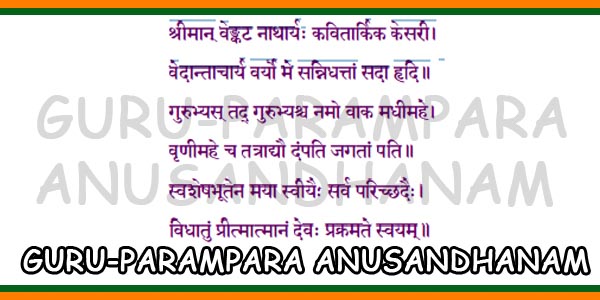
VIGHNA NIVARANAM / VISVAKSENA DHYANAM
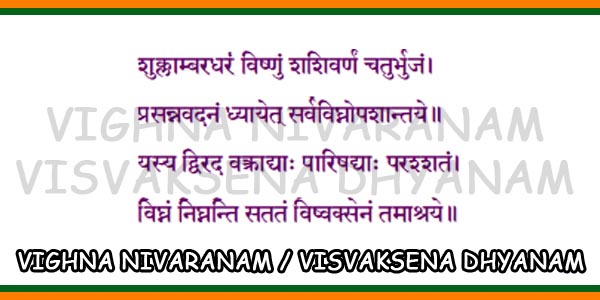
MAHA-SANKALPAM:
On your right thigh, place your left palm facing upwards and place right palm on top of it.
hariH om tat SrI govinda govinda govinda!
asya SrI-bhagavato mahA-purushasya vishNor AGYayA pravartamAnasya adya brahmaNah dvitIya-parArdhe SrI-SvetavarAha-kalpe vaivasvata-manvantare kaliyuge prathamapAde jambudvIpe, bhAratavarshe, bharatakhaNDe (USA residents substitute: krau~nca dwIpe, ramaNaka varShe, uttara or gotIrtha khaNde), SakAbde, meror dakshiNe pArSve asmin vartamAnAnAm vyAvahArikANAm prabhavAdi shashTi samvatsarANAm madhye.
(REPLACE THE APPROPRIATE NAMES FOR THE YEAR, AYANAM, RITU, MONTH, DAY AND STAR FROM THE NOTES ON FIRST PAGE ACCORDING TO THE COUNTRY WHERE THE UPAKARMA IS BEING PERFORMED.
year nAma samvatsare ayanam ayane, ritu Ritau, month mAse, Sukla pakshe, paurNamAsyAm Subha-tithau, SrI-vishnu-yoga SrI-vishnu-karaNa Subha-yoga Subha-karaNa evam guNa-viSeshaNa viSishTAyAm, asyAm Subha-tithau, SrI-bhagavadAjnayA [SrIman-nArAyaNa-prItyartham OR bhagavat-kainkaryarUpam OR bhagavat-prItyartham, depending on sampradAya]
taishyAm paurNamAsyAm adhyAya-utsarjana-akaraNa-prAyaScittaartham,
ashTottara-sahasra (1008) [or ashTottara-Sata (108)] sankhyayA “kAmo’kArshIt manyur akArshIt” mahAmantra-japam karishye.
Discard the folded darbhais towards northern direction. Do not remove the pavithram. Fold
your hands and perform saathvika thyaagam.
SATTVIKA TYAGAM:
bhagavAneva svaniyAmya swarUpasthiti pravR^itti svaSeshataikarasena anena aatmanaa kartraa svakIyaishcopakaraNaiH svArAdhanaika-prayojanAya parama purushaH sarvaSeshii shriyaH
patiH svaSesha bhuutamidam kAmo’kArshIt manyurakArshIt iti mahAmantra-japaakhyam karma svasmai svaprItaye svayameva kArayati

(REPLACE THE APPROPRIATE NAMES FOR THE YEAR, AYANAM, RITU, MONTH, DAY AND STAR FROM THE NOTES ON FIRST PAGE ACCORDING TO THE COUNTRY WHERE THE UPAKARMA IS BEING PERFORMED.

Discard the folded darbhais towards northern direction. Do not remove the pavithram. Fold
your hands and perform saathvika thyaagam.
SATTVIKA TYAGAM

PERFORM JAPAM BY RECITING EITHER 1008 TIMES OR 108 TIMES AS RESOLVED:
“kAmo’kArshIt manyur akArshIt”
Perform Achamanam Once and then perform sAttvika tyAgam by reciting:
bhagavAneva svaniyAmya swarUpasthiti pravR^itti svaSeshataikarasena
anena aatmanaa kartraa svakIyaishcopakaraNaiH
svArAdhanaika-prayojanAya parama purushaH sarvaSeshii shriyaH
patiH svaSesha bhuutamidam kAmo’kArshIt manyurakArshIt iti
mahAmantra-japaakhyam karma svasmai svaprItaye svayameva
kAritavaan.
The first part of the Upakarma procedure is completed now.
********************
Perform mAdhyAhnikam, including mAdhyAhnika snAnam if one is accustomed, followed by bhagavad-ArAdhanam. After this, strictly speaking, one should wait until after midday (aparAhna) to perform the upAkarma, but these days, due to exigencies of work, etc., people do it earlier.
Facing East perform Achamanam Twice and sit down on a seat with two darbhais. Wearing a
pavitram on your right hand ring finger, perform praanayaamam three times.
Folding your hands in anjali mudra do maha-sankalpam by reciting:
SrImAn venkaTanAthAryaH kavitArkika kesarI |
vedAntAcArya varyo me sannidhattAm sadA hRdi ||
gurubhyas tad gurubhyaS ca namo vAkam adhImahe |
vRiNImahe ca tatrAdyau dampatI jagatAm patI ||
sva-sesha-bhUtena mayA svIyaiH sarva paricchadaiH |
vidhAtum prItam AtmAnam devaH prakramate svayam ||
SuklAmbaradharam vishNum SaSivarnam caturbhujam |
prasanna-vadanam dhyAyet sarva-vighnopaSAntaye ||
yasya dvirada-vaktrAdyAH pAriSadyAH paraH Satam |
vighnam nighnanti satatam viSvasenam tam ASraye ||
PERFORM JAPAM BY RECITING EITHER 1008 TIMES OR 108 TIMES AS RESOLVED:
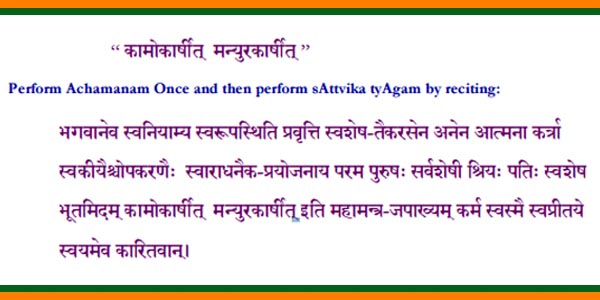
The first part of the Upakarma procedure is completed now.
*********
Perform mAdhyAhnikam, including mAdhyAhnika snAnam if one is accustomed, followed by
bhagavad-ArAdhanam. After this, strictly speaking, one should wait until after midday
(aparAhna) to perform the upAkarma, but these days, due to exigencies of work, etc., people do it earlier.
Facing East perform Achamanam Twice and sit down on a seat with two darbhais. Wearing a
pavitram on your right hand ring finger, perform praanayaamam three times.
Folding your hands in anjali mudra do maha-sankalpam by reciting:
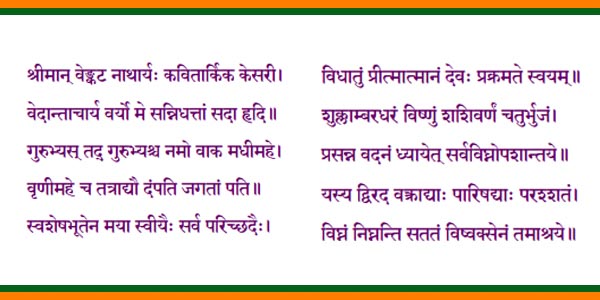
Do Mahasankalpam by reciting:
On your right thigh, place your left palm facing upwards and place right palm on top of it.
hariH om tat SrI govinda govinda govinda!
asya SrI-bhagavato mahA-purushasya vishNor AGYayA pravartamAnasya adya brahmaNah dvitIya-parArdhe SrI-SvetavarAha-kalpe vaivasvata-manvantare kaliyuge prathamapAde jambudvIpe, bhAratavarshe, bharatakhaNDe (USA residents substitute: krau~nca dwIpe, ramaNaka varShe, uttara or gotIrtha khaNde), SakAbde, meror dakshiNe pArSve asmin vartamAnAnAm vyAvahArikANAm prabhavAdi shashTi samvatsarANAm madhye year nAma samvatsare ayanam ayane, ritu Ritau, month mAse, Sukla pakshe, paurNamAsyAm Subha-tithau,
SrI-vishnu-yoga SrI-vishnu-karaNa Subha-yoga Subha-karaNa evam guNa-viSeshaNa viSishTAyAm, asyAm Subha-tithau, SrI-bhagavadAjnayA [SrIman-nArAyaNa-prItyartham OR bhagavat-kainkaryarUpam OR bhagavat-prItyartham, depending on sampradAya]
SrAvaNyAm paurNamAsyAm adhyAya-adhyAya-upAkarma karishye
tad angam kAndarshi-tarpaNam karishye
tad angam yajnopavIta-dhAraNam karishye
tad angam snAnam karishye
BRAHMACHARIS ADD the line below:
tad angatayA maunji-ajina-daNDa-dhAraNAni karishye
Perform saatvika thyaagam by reciting:
bhagavAneva svaniyAmya swarUpasthiti pravR^itti svaSeshataikarasena
anena aatmanaa kartraa svakIyaishcopakaraNaiH
svArAdhanaika-prayojanAya parama purushaH sarvaSeshii shriyaH
patiH svaSesha bhuutamidam shraavaNyaam paurnamaasyaam
adhyayopaakarmaakhyam karma svasmai svaprItaye svayameva
kArayati.
Do Mahasankalpam by reciting:
On your right thigh, place your left palm facing upwards and place right palm on top of it.
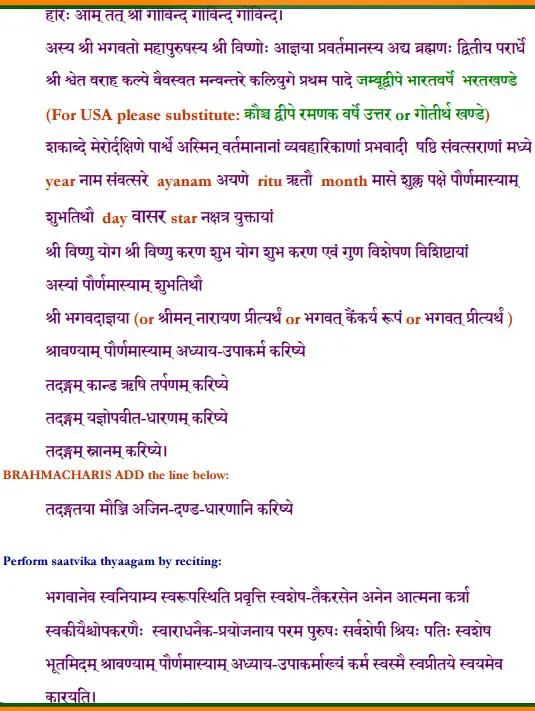
Now recite with folded hands
apavitraH pavitro va sarvaavasthaam gatopivaa
yaH smaret puNDarIkaakShaM sa baahyaabhyantaraH shuchiH
shrI harirhariH puNDarIkaakShaaya namaH
Now sprinkle some water on yourself as a mAnasika snAnam. The very orthodox, performing
this ritual at a river bank or pushkariNi, would have done the snAnam immediately upon
reaching the water.
WEAR THE NEW YAJNOPAVITAM (POONOOL-S) WITH APPROPRIATE MANTRAS:
Perform sankalpam (Posture: Place left palm on right thigh and place right palm over the left
palm), with sAttvika tyAgam by reciting:
adya pUrvoccarita evam guNa-viseshaNa-viSishTAyAm, asyAm
Subha tithau, SrI-bhagavad-AjnayA SrIman-nArAyaNa-prItyartham
(or variant) Srauta-smArta-vihita-nitya-karma-anushThAnayogyatA-siddhyartham
yajnopavIta-dhAraNam karishye
bhagavAneva svaniyAmya swarUpasthiti pravR^itti svaSeshataikarasena
anena aatmanaa kartraa svakIyaishcopakaraNaiH
svArAdhanaika-prayojanAya parama purushaH sarvaSeshii shriyaH
patiH svaSesha bhuutamidam yaGYopavItadhaaraNaakhyam karma
svasmai svaprItaye svayameva kArayati.
Put one yajnopavItam on at a time. To do this, sit squatting (kukkuTTAsanam) facing east.
Hold the yajnopavItam with both hands, with your right palm facing up over your head, and
your left palm facing the ground. The top of the brahma-mudi (knot) should be on your right palm and should be facing right. Then say this mantra, while touching the scalp with your
right fingers:
yajnopavIta-dhAraNa-mantrasya brahmA Rshi:
Touch your nose and recite:
trishTup chandaH
Touch your chest and recite:
trayIvidyA devatA yajnopavIta dhAraNe viniyogah 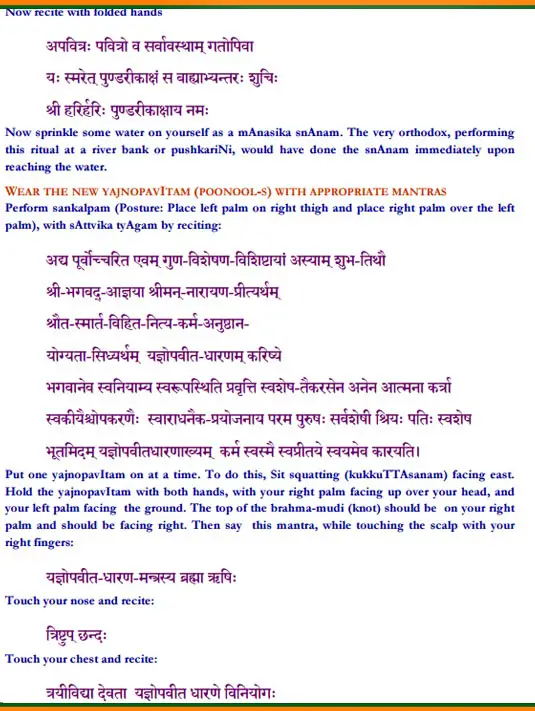
After reciting the following mantra wear one set of yagyopavitam
yajnopavItam paramam pavitram, prajApater yat sahajam purastAt
Ayushyam agryam pratimunca Subhram yajnopavItam balamastu teja:
Perform Achamanam Once.
IF MARRIED do prANAyAmam and perform sankalpam, with sAttvika tyAgam by reciting:
pUrvoccarita evam guNa-viseshaNa-viSishTAyAm, asyAm Subha-tithau,
SrI-bhagavad-AjnayA SrIman-nArAyaNa-prItyartham (or variant)
graahasthyArham dvitIya yajnopavIta-dhAraNam karishyE
Put the second yajnopavItam on at this time. To do this, hold the yajnopavItam with both
hands, with your right palm facing up over your head, and your left palm facing the ground.
The top of the brahma-mudi (knot) should be on your right palm and should be facing right.
Then say this mantra, while touching the scalp with your right fingers:
yajnopavIta-dhAraNa-mantrasya brahmA Rishi:
Touch your nose and recite:
trishTup chandaH
Touch your chest and recite:
trayIvidyA devatA yajnopavIta dhAraNe viniyogah
After reciting the following mantra wear one set of yagyopavitam
yajnopavItam paramam pavitram, prajApater yat sahajam purastAt
Ayushyam agryam pratimunca Subhram yajnopavItam balamastu teja:
Now wear the second yajnopavItam. Perform Achamanam Once.
Common to BOTH Brahmacharis and Grahasthyaas
After saying
upavItam chinnantu jIrNam kaSmala-dUshitam |
visRjAmi punar brahman varco dIrghAyur astu me ||
Remove the old yajnopavItam(s) and discard them under a tree, in a river, or some other
natural place. Don’t throw them in the garbage!
Perform Achamanam
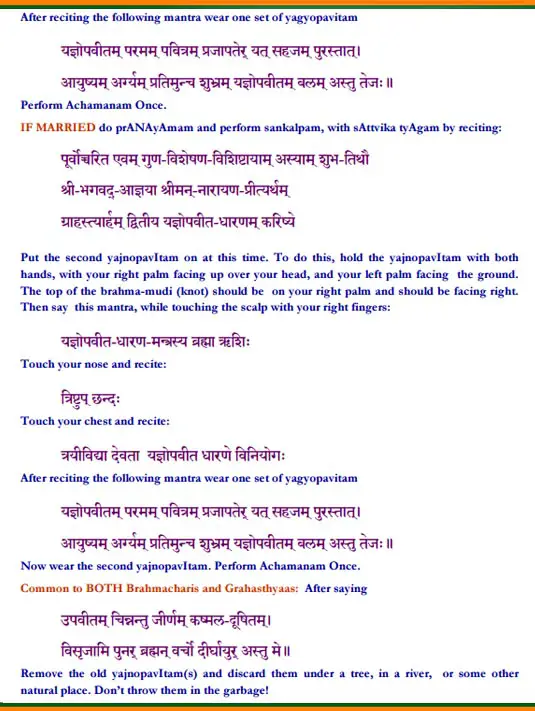
Perform sAttvika tyAgam by reciting:
bhagavAneva svaniyAmya swarUpasthiti pravR^itti svaSeshataikarasena
anena aatmanaa kartraa svakIyaishcopakaraNaiH
svArAdhanaika-prayojanAya parama purushaH sarvaSeshii shriyaH
patiH svaSesha bhuutamidam yaGYopavItadhaaraNaakhyam karma
svasmai svaprItaye svayameva kAritavaan
This completes the procedure of wearing the yagyopavItham
BRAHMACHARIS SHOULD RECITE MANTRAS FOR THE DARBHA BELT (MAUNJI), KRISHNAJINA (A PIECE OF DEER SKIN), AND PALASA DANDA AND IF POSSIBLE WEAR THEM.
(1) maunji (wear a darbha belt around waist after reciting)
iyam duruktAt paribAdhamAnA Sarma varUtham punatIna AgAt
prANApAnAbhyAm balamAbharantI priyA dEvAnAGM subhagA
mEkhaleyam
Rtasya gOptrI tapasa: parasvIghnatI raksha: sahamAnA arAtI:
sAna: samantamanu parIhi bhadhrayA bhartAraste mekhale mA rishAma
(2) ajina (a piece of deer skin is to be tied to yagyopavItham after this)
mitrasya cakshur dharuNam balIyas tejo yaSasvi sthaviraM samiddham
anAhanasyam vasanam jarishNu parIdham vAjyajinam dadhe’ham
(3) daNDa hold a palaasa dandam in hand or, if unavailable, darbhai
suSravassuSravasam mA kuru yathA tvaM suSrava: susravA asyevamahaM
suSravassuSravA bhUyAsam yathA tvaM suSravassuSravo devAnAm
nidhigOpO syevamaham brAhmaNAnAm brahmaNo nidhigOpO
bhUyAsam ||
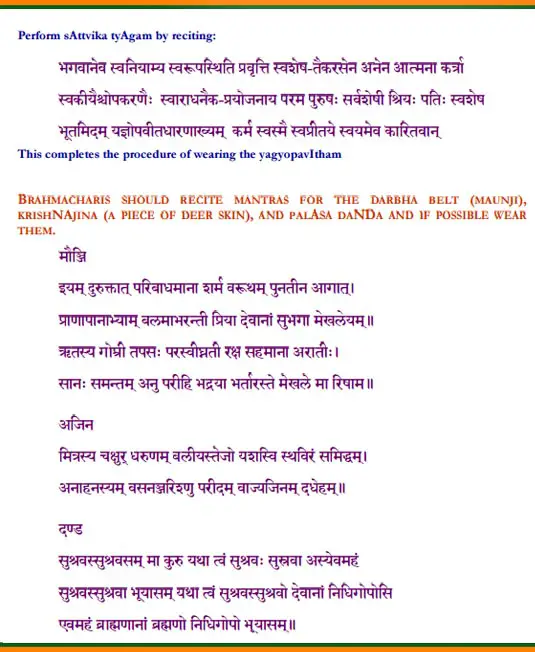
NAVA KANDA RISHI TARPANAM
Perform Achamanam Twice followed by saathvika thyaagam by reciting:
bhagavAneva svaniyAmya swarUpasthiti pravR^itti svaSeshataikarasena
anena aatmanaa kartraa svakIyaishcopakaraNaiH
svArAdhanaika-prayojanAya parama purushaH sarvaSeshii shriyaH
patiH svaSesha bhuutamidam navakaaNDarishitarpaNaakhyam
karma svasmai svaprItaye svayameva kArayati
For each of the following, offer a mixture of (uncooked) rice, black sesame seeds (eL), and
water, as you say ‘tarpayAmi’. Each line should be said THREE times. Preferably, someone
should help by pouring the water as you release the rice and sesame, as this makes it easier.
Stand facing north, wear the yajnopavItam as a necklace (nivItam). Cup both your hands
together, having the yajnopavItam’s brahma-mudi (knots) resting in your palms and with the
threads going between your thumb and forefinger of each hand. The water should be released
along with the sesame and rice between the two hands, at the base of the little fingers. This is known as Rshi tIrtham.
prajApatim kANDarshim tarpayAmi
sOmam kANDarshim tarpayAmi
agnim kANDarshim tarpayAmi
viSvAn devAn kANDarshIn tarpayAmi
sAmhitIr devatA upanishadas tarpayAmi
yajnikIr devatA upanishadas tarpayAmi
vAruNIr devatA upanishadas tarpayAmi
Now, still with nivItam, the water mixture should be released towards you, off of the base of
the hands near the palms (i.e., away from the fingertips). Typically this is done by pointing the fingers straight up, keeping the sides of the hands together. This is known as brahma-tIrtham.
brahmANaM svayambhuvam tarpayAmi
Now the water should be poured as deva-tIrtham. This means that the water mixture should
be poured off the tips of the fingers.
sadasaspatim tarpayAmi
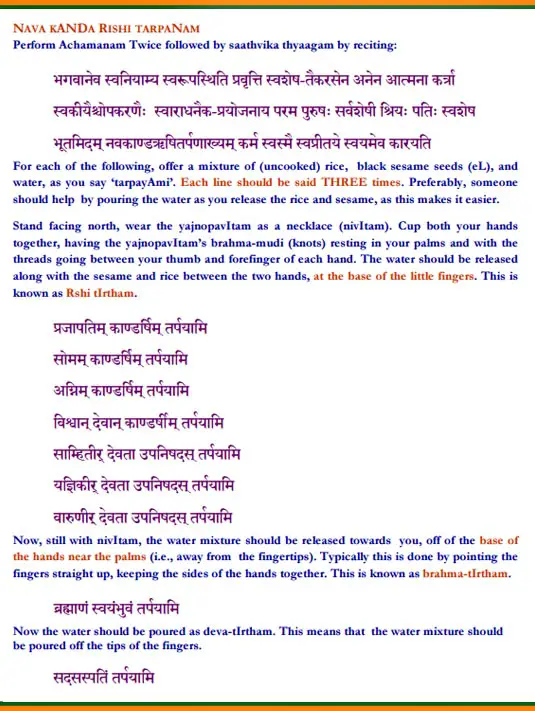
After the kANDa-rishi tarpaNam, some people add:
Rg-vedam tarpayAmi
yajur-vedam tarpayAmi
sAma-vedam tarpayAmi
atharvaNa-vedam tarpayAmi
itihAsam tarpayAmi
purANam tarpayAmi
kalpam tarpayAmi
Some also now recommend pitR tarpaNam (prAcIna-vItam) for those whose fathers are no
longer alive.
Return to upavItam, i.e., your poonool in its normal position.
Finish with Acamanam and sAttvika tyAgam.
bhagavAneva svaniyAmya swarUpasthiti pravR^itti svaSeshataikarasena
anena aatmanaa kartraa svakIyaishcopakaraNaiH
svArAdhanaika-prayojanAya parama purushaH sarvaSeshii shriyaH
patiH svaSesha bhuutamidam navakaaNDarishitarpaNaakhyam
karma svasmai svaprItaye svayameva kAritavaan
Traditionally there is now a upAkarma homa, where the rishis and devatAs mentioned above
are once again saluted using the sacred fire. Then there is vedArambha, where the first four
anuvAkas of the yajur veda samhita are taught to the sishyas. This is the most important part
of the upAkarma. This is followed by jayAdi homam.
These may not be available if one is away from one’s elders and acharyas. At minimum, it is
recommended that you recite one anuvAka from your veda on this day. The Purusha Sukta
suffices, for example. If you haven’t learnt any of your veda, you should do gAyatrI japam in
its place.
After the kANDa-rishi tarpaNam, some people add:
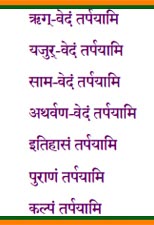
Some also now recommend pitR tarpaNam (prAcIna-vItam) for those whose fathers are no
longer alive.
Return to upavItam, i.e., your poonool in its normal position.
Finish with Acamanam and sAttvika tyAgam.

Traditionally there is now a upAkarma homa, where the rishis and devatAs mentioned above
are once again saluted using the sacred fire. Then there is vedArambha, where the first four
anuvAkas of the yajur veda samhita are taught to the sishyas. This is the most important part
of the upAkarma. This is followed by jayAdi homam.
These may not be available if one is away from one’s elders and acharyas. At minimum, it is
recommended that you recite one anuvAka from your veda on this day. The Purusha Sukta
suffices, for example. If you haven’t learnt any of your veda, you should do gAyatrI japam in
its place.
Notes:
For a Pictorial Guide to Yajur & Sama Upakarma (with Audio).
(a) On the UpAkarma day, strictly speaking, the rule is to eat only after bhagavad-ArAdhana and the homam. If done properly this lasts well into the afternoon. Because of the length of the procedure, young brahmacharis and those others who are absolutely unable to bear their hunger are permitted to eat before the homam itself. The typical meal consists of idli and appam, but usually excludes rice. Complete fasting is observed after this through the night, in preparation for the next day’s gAyatrI japam. In some traditions one meal is eaten during the day and phalAhAram is observed at night.
(b) The mantra for the kAmo’kArshIt japam is “kAmo’kArshIt manyur akArshIt”. Most authorities end with this, and do not follow it by anything else. However, in some traditions, the mantra is “kAmo’kArshIt manyur akArshIt namo namaH”.
(c) Some people also change their yajnopavItam before the kAmo’kArshIt japam, in addition
to the changing done for upAkarma itself. It should be remembered that the changing before
upAkarma is the more important one, and if one only wants to change once, the upAkarma
changing is preferred.
The reason for this is as follows. the kAmo’kArshIt japam is done as an atonement, a
prAyaScittam for not having done the traditional utsarjana sankalpa earlier in the year. The
sankalpa for the japam says this explicitly (‘adhyAya-utsarjana-akaraNa’). Just as upAkarma is the formal recommencement of Vedic studies, the utsarjana is a sankalpa done to formally halt study of the Vedas and commence study of grammar, prosody, pronounciation, astronomy, etymology, etc., as well as other shastras, all of which are helpful in understanding
the Vedas. The year was therefore divided into two, one half for studying the Vedas, the other half for studying the VedAngas or Vedic accessories.
The utsarjana has unfortunately fallen into disuse for quite a while, so what remains is the
meager prAyaScittam for not having done it. Therefore, the important yajnopavItam changing
is for the upAkarma.
(d) sAttvika tyAgam It is a moment of contemplation whereby one dedicates the act and all its
fruits entirely to Bhagavan, and where one recognizes that Bhagavan himself is performing
the act through you entirely for His own purposes. Typically, as an expression of this attitude, a brief sentence is stated before and after performing the karma.
(e) It is often erroneously thought that upAkarma or AvaNi aviTTam is primarily the changing the yajnopavItam (poonool). This cannot be further from the truth. Changing the poonool happens very often, whenever a significant vedic karma is performed. UpAkarma, however, is a rededication of oneself to the study of one’s Veda, along with salutations to the rishis who
perceived and revealed the Vedic mantras to the world. This is the significance of the
navakANDarshi tarpaNam and the anuvAka recitation.
(f) Achamanam: (RH= Right hand)
